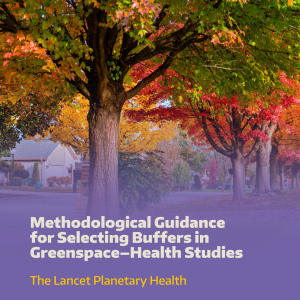Methodological Guidance for Selecting Buffers in Greenspace–Health Studies
Citation
Sakhvidi, M. J. Z., Browning, M. H., Samuelsson, K., Labib, S. M., Psyllidis, A., Ameagah, A. K., … Bratman, G. N., … & Dadvand, P. (2025). Methodological guidance for selecting buffers in greenspace and health studies. The Lancet Planetary Health. doi.org/10.1016/j.lanplh.2025.101370
 Parks, trees, and other green spaces can promote public health. To study this, scientists often look at how much green space is near where people live or spend time. They usually measure this by drawing a boundary around a home or place and checking how much green space is inside it. This is called a buffer. Different studies use different kinds and sizes of buffers, making it hard to compare results.
Parks, trees, and other green spaces can promote public health. To study this, scientists often look at how much green space is near where people live or spend time. They usually measure this by drawing a boundary around a home or place and checking how much green space is inside it. This is called a buffer. Different studies use different kinds and sizes of buffers, making it hard to compare results.
In this Personal View, a group of interdisciplinary experts worked together to find a better way to choose and use buffers. They looked at different methods—from simple ones that only considered a single location, to more detailed ones that include places a person goes throughout the day. They also looked at what should guide these choices, such as the health issue being studied, who is being studied, and what data are available.
The experts recommend that researchers should:
- Choose buffer types and sizes based on clear reasons related to how green space might affect health.
- Use methods that consider where people spend time, where feasible.
- Try different buffer sizes to see how results change.
Overall, researchers should move away from one-size-fits-all methods of measuring people’s exposure to green spaces. Instead, they should use approaches that are tailored to individuals, take into account different scales and situations, and are clearly explained. The experts also recommend setting standards for how and why certain buffers are chosen for analysis, so that studies are more accurate, easier to compare, and more useful when synthesized.
Abstract
Greenspace can promote health via diverse pathways. A common approach to assessing greenspace exposure is to estimate vegetation availability within buffers surrounding locations where people reside or spend time. However, no clear framework for informed buffer selection exists, and choices made show considerable heterogeneity, impeding evidence synthesis and causal inference. In this Personal View conducted by an interdisciplinary panel of experts, we aimed to establish a framework for informed buffer selection for epidemiological studies on greenspace. We began by reviewing available approaches for the selection of buffer types, which range from single fixed-location approaches to high-resolution mobility-based activity-space approaches, as well as different buffer sizes. We then summarised the determinants of buffer type and size selection including health outcomes and underlying mechanisms, study population, contextual factors, and data characteristics. Finally, based on these determinants, we developed recommendations for future research. Buffer type and size selection should be hypothesis driven, reflecting presumed greenspace–health mechanisms. Buffer selection should target activity-based approaches where feasible, and multiple buffer sizes should be tested. Overall, the assessment of greenspace exposure should shift from ad-hoc approaches to personalised, multiscale, and context-specific methods. We call for standardising and reporting the rationale for buffer selection to minimise bias and enhance comparability and evidence synthesis across studies.